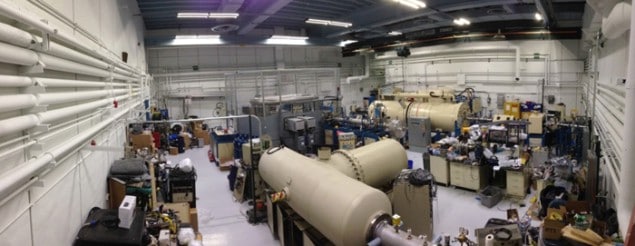
Damage to nuclear-reactor components caused by neutron irradiation across several years can be simulated with ion beams in just a few days. That is the finding of researchers in the US, who have used ions to create the same fabric of tiny structural defects found in long-running reactors. The new technique could help engineers anticipate problems arising in existing facilities and inform the development of more robust reactor designs for the future.
Neutron irradiation can have significant effects on the structure of materials used in nuclear reactors. Individual atoms can be displaced and larger defects can build up over time, weakening or even deforming the material. Understanding the nature and extent of this damage is important to ensure safe reactor operation.
One approach is to place samples in test reactors that can produce damage at a faster rate than their working counterparts. However, these facilities are expensive to operate and can still take decades to produce the required levels of damage.
Ions instead
An alternative solution lies in replicating neutron damage with a different type of irradiation: ion beams. Building on decades of research, Gary Was of the University of Michigan and colleagues have unveiled the first working emulation of neutron damage using ion beams. “The amount of damage that is created with an ion is very dependent on its energy,” Was explains. “It turns out that the damage spectrum from 5 MeV ions is pretty close to that from fission neutrons.”
The team demonstrated the concept by trying to recreate damage seen in a steel duct that for seven years had surrounded the fuel assembly in a nuclear reactor on the Hanford Site in Washington. Microstructural damage to the duct had already been studied extensively by researchers from the Los Alamos National Laboratory using atom probe microscopy, electron microscopy and other techniques.
Atoms on the move
Using a sample made from metal from the same batch that was used to manufacture the original duct, Was and colleagues followed a two-stage analysis procedure at the Michigan Ion Beam Laboratory. First, a beam of helium ions is used to insert helium nuclei into the sample. This simulates the in-reactor production of helium by neutrons. The second stage involves heating the sample to 460 °C and subjecting it to a beam of iron ions. The sample itself is mostly iron as well, and the introduction of these ions simulates atomic displacements within the material without introducing any new elements.
One possible drawback of using ions is that unlike neutrons, which easily penetrate deep into materials and cause damage throughout, ion beams only scratch the surface of a sample. This means that the effects of ion-beam irradiation are confined to within a micron of the surface of the sample. However, the researchers explain that this creates more than enough damage for analysis.
The irradiation process lasts four days and creates the same fabric of damage seen in the original duct. Defects seen in both the sample and duct ranged from 1–20 nm in size and came in a variety of forms. These include dislocation loops, voids and precipitates – the latter being tiny regions containing a different structure than that of the surrounding material.
Translatable technique
According to Was, the method is already “quite translatable to other materials” and, in the future, the researchers hope to adapt it so that they can simulate a range of irradiation environments and reactor operational histories. In addition to assessing potential issues arising in existing reactors, the researchers hope that their method could help inform the development of the next generation of reactor designs. These plants will likely have more intense radiation environments than today’s facilities, and this will require components that are capable of withstanding higher levels of irradiation damage.
“The use of ion beams to mimic the irradiation damage produced in a reactor is a vital tool to developing a better understanding of how materials are affected by high-irradiation doses,” comments Philipp Frankel, a materials scientist at the University of Manchester. He adds that the work demonstrates exactly the type of validation studies need to provide confidence in these techniques.
Karl Whittle – a nuclear materials researcher from the University of Sheffield – agrees, but says that care must be taken when comparing the damage caused by different types of irradiation. Regardless, further work in this area, he says, would make it possible “to examine the long-term effects of damage, and develop mechanisms for mitigation of [its effects]”.
The research is described in the journal Scripta Materialia.



